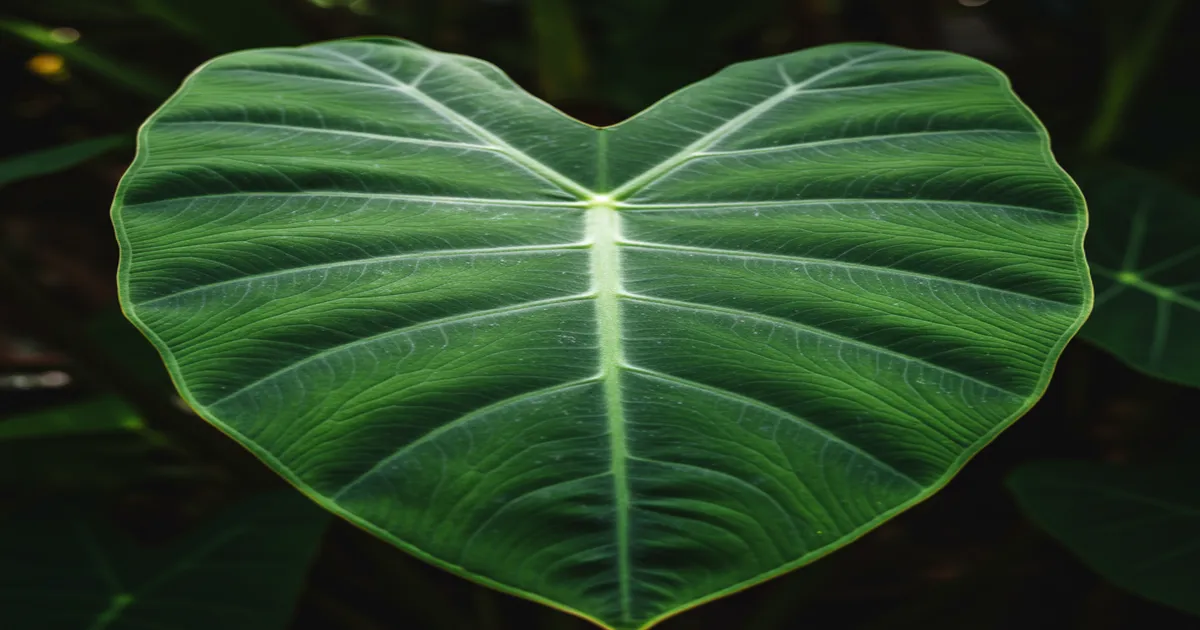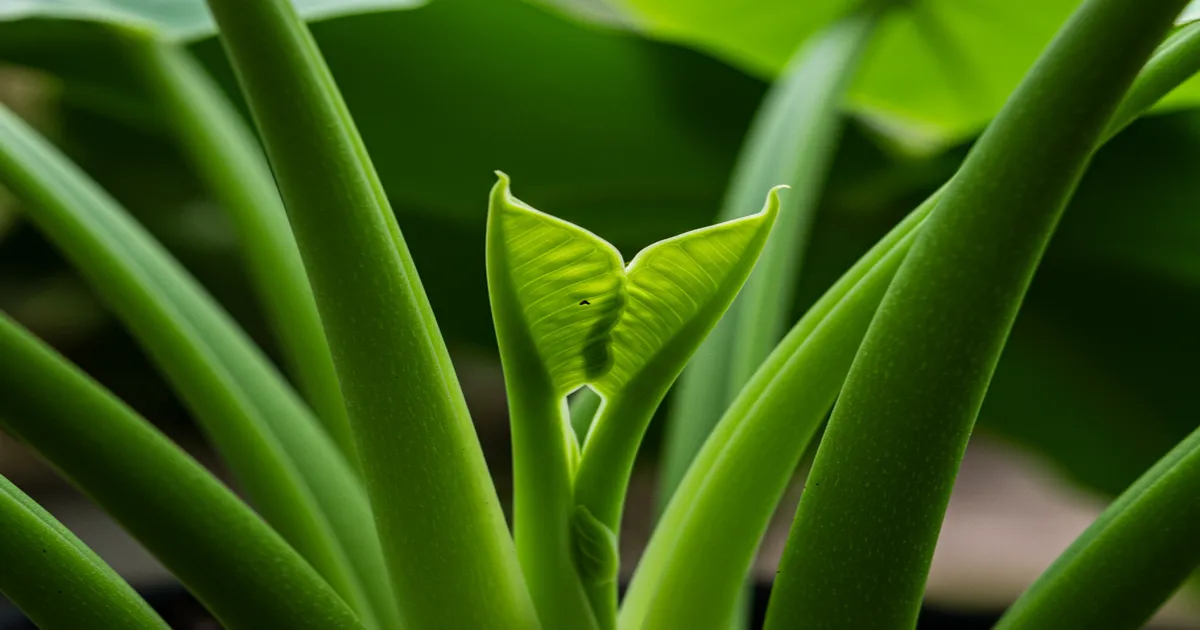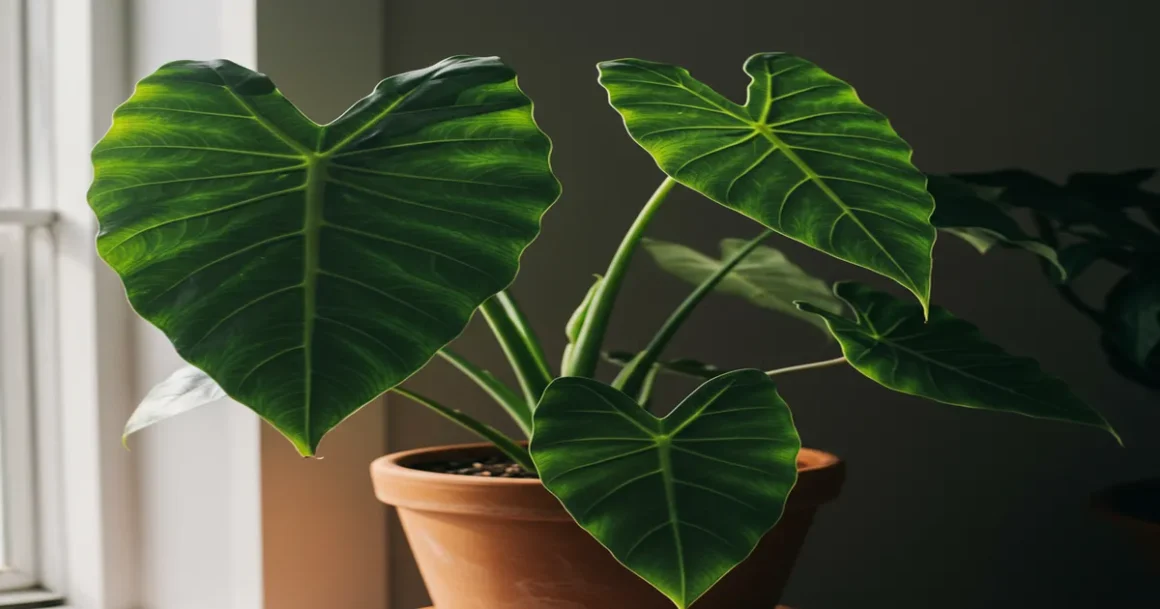Alocasia ‘Regal Shield’ is a striking tropical perennial plant with large, sprawling leaves that can thrive both indoors and outdoors. It belongs to the elephant ear plant family and may occasionally produce white or green flowers. This plant flourishes in partial sun and moist soil within a warm, humid environment. Like other Alocasia species, all parts of this plant are toxic to humans and animals.
| Common Name | Elephant Ear ‘Regal Shield’ |
| Botanical Name | Alocasia |
| Family | Araceae |
| Plant Type | Perennial |
| Mature Size | 4-5 ft. tall (indoors), 5-6 ft. tall (outdoors), 4-5 ft. wide |
| Sun Exposure | Full, partial |
| Soil Type | Loamy, moist but well-drained |
| Soil pH | Acidic, neutral |
| Bloom Time | Spring, summer |
| Flower Color | White, green |
| Hardiness Zones | 9-11 (USDA) |
| Native Area | Africa |
| Toxicity | Toxic to people, pets |
Trimming

Trimming the Alocasia plant will assist in channeling nutrients to the healthier leaves. Cut away any excessively grown, damaged, or yellowing leaves when necessary.
Alocasia Regal Shield Propagation

Propagating these plants is simple because the parent plant reproduces through corms. To do this, you will need a small pot with moist, well-draining soil and a sharp, sterile knife. Follow these steps:
Alternatively, you can try this method for propagating Alocasia:
Growing Alocasia Regal Shield from Seed

Alocasia Regal Shield plants can also be grown from seed, but it will take several years for the seedlings to reach full size. If you are up for a rewarding challenge and are willing to wait patiently, this method is worth considering.
To begin the process, you will need seeds, well-draining soil, peat moss, small pots or trays, and a misting bottle. Follow these steps:
Methods for Potting and Repotting Alocasia Regal Shield
Alocasia ‘Regal Shield’ thrives in containers, but it’s crucial to understand that these plants can be quite top-heavy. It’s important to select a pot that offers a stable base. These plants should be repotted every few years when they outgrow their current container. In such cases, simply opt for a pot that is a few inches larger than the current one. Ensure it has adequate drainage holes for excess water to escape. Carefully tilt the plant sideways, tap around the pot’s edges to loosen the roots, then gently remove the plant and transfer it to the new pot with fresh potting soil.
Wintering
When keeping this plant indoors, make sure to position it close to a well-lit window in the winter to guarantee it gets sufficient light. The plant might enter a dormant state, requiring less watering compared to the summer months. Refrain from using any fertilizer.
Elephant ear plants should not be left outside when temperatures fall below 55 degrees Fahrenheit. In such instances, remember to bring the plant indoors.
Types of Pests
Alocasia plants are susceptible to spider mites. To prevent this, ensure that the plant is not becoming excessively dry. Spider mites consume the plant’s sap, leading to yellow or brown discoloration of the leaves. They can also induce the formation of red bumps on the plant by releasing a toxin during feeding. The appearance of webbing on the leaves is a typical indication of a spider mite infestation.
Tips for Inducing Blooms in Alocasia ‘Regal Shield’
Many individuals are unaware that Alocasia ‘Regal Shield’ plants are capable of blooming, as it is a rare event.
Blooming Period
If you are fortunate enough to have a plant that blossoms, it typically happens during the spring and summer months.
Duration of Alocasia ‘Regal Shield’ Blooms
Remember that blooming occurs only when the plant is fully mature and under optimal conditions. Each individual bloom can last for two to three weeks.
Appearance and Fragrance of Alocasia ‘Regal Shield’ Flowers
The flowers of Alocasia ‘Regal Shield’ emerge on tall stems and resemble peace lilies. They are typically white to green in color and are not very showy.
Promoting Additional Blooms
Even in perfect conditions, Alocasia ‘Regal Shield’ may not flower. To stimulate flowering, ensure it is exposed to high humidity and consistent temperatures. Water the plant when the soil starts to dry out and apply fertilizer monthly during the growing season. With time and patience, your elephant ear plant may surprise you with a flower.
Post-Blooming Care for Alocasia ‘Regal Shield’
Once the flowering phase ends, the plant will enter a dormant period. During this time, water it sparingly and discontinue fertilization.
Removing Spent Alocasia ‘Regal Shield’ Flowers
To make room for new blooms, you can prune off faded flowers using sterilized gardening shears or scissors.
Issues commonly faced with Alocasia ‘Regal Shield’
Alocasia Regal Shield can sometimes be particular and will indicate if it is not happy with its current growing conditions. Below are some typical problems encountered when cultivating this plant and how to resolve them.
Leaves turning yellow and wilting
This is often a sign of overwatering. To address this, replace the soil with a mixture that drains better and reduce watering. The plant should recover in about a week.
Yellowing leaves with webs
This is likely due to a spider-mite infestation. Remove any affected leaves and dispose of them to prevent further spread. Use neem oil or another insecticidal solution to spray the plant.
Dry brown spots or edges
This indicates low humidity or insufficient watering. Check the soil with your finger to see if the plant needs water. Consider placing a humidifier nearby or misting the leaves to increase humidity for the plant.
FAQ
How quickly does Alocasia ‘Regal Shield’ grow?
These large plants grow relatively fast and can reach their full height within a few years. If you have a very small plant or have started from seed, it will take many years to reach its full height of 6 feet.
Is misting beneficial for Alocasia ‘Regal Shield’?
Alocasia ‘Regal Shield’ thrives in high humidity levels. Misting is a simple way to provide the needed humidity. If misting alone is insufficient, consider placing a humidifier near the plant.

